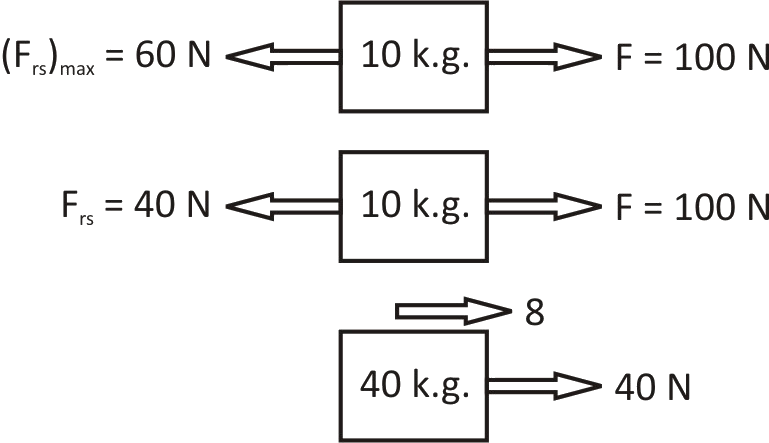
A \[40kg\] slab rests on a frictionless floor as shown in the figure. A \[10kg\] block rests on top of the slab. The static coefficient of friction between the block and the slab is 0.60 while the kinetic coefficient is 0.40. The \[10kg\] block is acted upon by a horizontal force of 100N. If \[g = 10m/{s^2}\] the resulting acceleration of the slab will be?
Answer
556.8k+ views
Hint: Analyse whether the blocks move together or not, and for that find acceleration of total mass and then use the appropriate formula to find the acceleration and then solve it further to get the Answer.
Complete step by step answer:

Here it is given that
A 40kg slab rests on a frictionless floor and a 10kg block rests on top of the slab
The value of static coefficient of friction in between the given slab and block is\[{\mu _s} = 0.60\]
The value of kinetic coefficient of friction in between the given slab and block is\[{\mu _k} = 0.40\]
As per given-
1. Maximum Static Friction Force-
\[{({F_{rs}})_{\max }} = {\mu _s} \times R\] [R=Reaction Force, R=mg]
Now, Putting the values in the formula we have
\[{({F_{rs}})_{\max }} = 0.6 \times 10 \times 10 = 60N\]
2. Kinetic Friction Force-
\[({F_{rk}}) = {\mu _k} \times R = 0.4 \times 10 \times 10 = 40N\]
Now,
Case 1: If both the block and slab move together

This is not possible because \[F > ({F_{rs}})\max \]
Case 2- Relative Motion between block and slab

In this case according to the free body diagram as shown above: For 40 kg slab the net force will be :
\[{F_{net}} = 40N\]
\[
\Rightarrow m \times a = 40N \\
\Rightarrow F = {\mu _m}^1g \\
\Rightarrow a = \dfrac{f}{m} \\
\]
\[a = \dfrac{{40}}{{40}} = 1m/{s^2}\]
Note:
Whenever such types of question appears then always write down the things given in the question then find the acceleration of total mass due to the application of a horizontal force of 100N on the block of 10kg and then find the maximum frictional force on the block, then we observe that the frictional force is smaller than the applied force and it proves that the block and the slab are not moving relative to each other. So, we can write for the block that\[{\text{F = }}{{\text{\mu }}_{\text{m}}}^{\text{1}}{\text{g}}\] and then after finding the value of F.
Complete step by step answer:

Here it is given that
A 40kg slab rests on a frictionless floor and a 10kg block rests on top of the slab
The value of static coefficient of friction in between the given slab and block is\[{\mu _s} = 0.60\]
The value of kinetic coefficient of friction in between the given slab and block is\[{\mu _k} = 0.40\]
As per given-
1. Maximum Static Friction Force-
\[{({F_{rs}})_{\max }} = {\mu _s} \times R\] [R=Reaction Force, R=mg]
Now, Putting the values in the formula we have
\[{({F_{rs}})_{\max }} = 0.6 \times 10 \times 10 = 60N\]
2. Kinetic Friction Force-
\[({F_{rk}}) = {\mu _k} \times R = 0.4 \times 10 \times 10 = 40N\]
Now,
Case 1: If both the block and slab move together

This is not possible because \[F > ({F_{rs}})\max \]
Case 2- Relative Motion between block and slab

In this case according to the free body diagram as shown above: For 40 kg slab the net force will be :
\[{F_{net}} = 40N\]
\[
\Rightarrow m \times a = 40N \\
\Rightarrow F = {\mu _m}^1g \\
\Rightarrow a = \dfrac{f}{m} \\
\]
\[a = \dfrac{{40}}{{40}} = 1m/{s^2}\]
Note:
Whenever such types of question appears then always write down the things given in the question then find the acceleration of total mass due to the application of a horizontal force of 100N on the block of 10kg and then find the maximum frictional force on the block, then we observe that the frictional force is smaller than the applied force and it proves that the block and the slab are not moving relative to each other. So, we can write for the block that\[{\text{F = }}{{\text{\mu }}_{\text{m}}}^{\text{1}}{\text{g}}\] and then after finding the value of F.
Recently Updated Pages
Master Class 11 Economics: Engaging Questions & Answers for Success

Master Class 11 English: Engaging Questions & Answers for Success

Master Class 11 Social Science: Engaging Questions & Answers for Success

Master Class 11 Biology: Engaging Questions & Answers for Success

Class 11 Question and Answer - Your Ultimate Solutions Guide

Master Class 11 Business Studies: Engaging Questions & Answers for Success

Trending doubts
10 examples of friction in our daily life

One Metric ton is equal to kg A 10000 B 1000 C 100 class 11 physics CBSE

Difference Between Prokaryotic Cells and Eukaryotic Cells

1 Quintal is equal to a 110 kg b 10 kg c 100kg d 1000 class 11 physics CBSE

Explain zero factorial class 11 maths CBSE

What is a periderm How does periderm formation take class 11 biology CBSE




